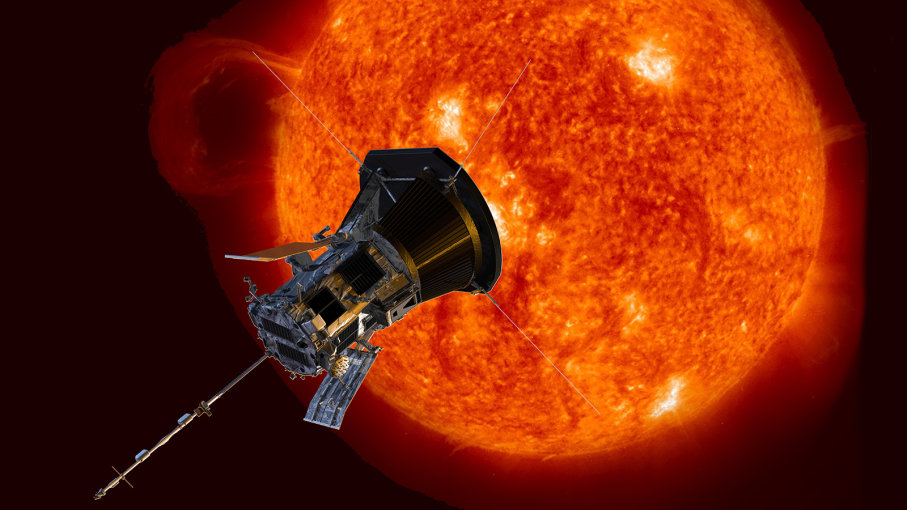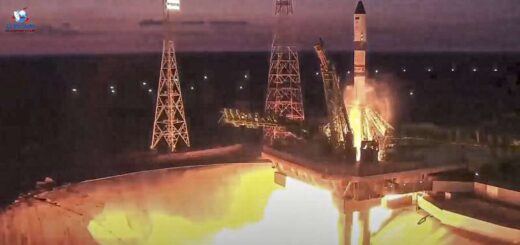How Close Can We Get to the Sun?

NASA’s Parker Solar Probe will provide new data on solar activity and help us forecast major space-weather events that impact Earth. NASA/JOHNS HOPKINS APL/STEVE GRIBBEN
Four million miles (or if you prefer, 6.44 million kilometers) is quite a distance. It’s the equivalent of driving around Earth’s widest point, the equator, 160 times in a row.
Well that’s about as close to the sun as NASA is willing to take its new Parker Solar Probe (PSP). Scheduled to launch out of the Cape Canaveral Air Force Station later this month, the vessel will gather data on our sun and hopefully answer some basic questions we still have about it.
The PSP is about to make history as well. Eventually, its orbital path will take it just 3.83 million miles (6.16 million kilometers) away from the big yellow star.
Such proximity is completely unprecedented. NASA’s Helios 2 probe came within 27 million miles (43.45 million kilometers) of the surface of the sun in 1976. That’s closer than any other spacecraft has ever come to this heavenly body.
Ah, but records invite challengers. The Parker Solar Probe will get about seven times closer than Helios 2 did. Planet Earth and the sun are 93 million miles (150 million kilometers) apart. One NASA scientist said that if the two bodies stood on opposite ends of an American football field, the PSP’s mission would bring it all the way to the sun’s 4-yard line.
Solar exploration technology has come a long way. Yet engineers still need to keep a few limitations in mind — and it doesn’t look like we’ll be sending astronauts on a journey towards the sun anytime soon.
High Heat and the Corona Mystery
Extreme heat is the most obvious concern. The sun’s surface temperature is a stifling 10,340 degrees Fahrenheit (5,726 degrees Celsius). Curiously though, the area that surrounds the sun is even hotter.
You know that halo of light that creeps out from behind the moon during a solar eclipse? That’s the corona. A layer of blistering plasma, it represents the uppermost portion of the sun’s atmosphere. The corona begins roughly 1,300 miles (2,100 kilometers) above the surface and extends far into space.
Parts of it get hot. Very hot. In some places, the corona is liable to be 300 times hotter than the surface. No one knows why this is; NASA hopes that the Parker Solar Probe will find some clues.
Spacesuits used by NASA astronauts can protect them from temperatures of up to 250 degrees Fahrenheit (121 degrees Celsius). Space travelers wouldn’t encounter such extreme heat until they ventured 3 million miles (4.8 million kilometers) away from the sun. Beyond that point, the high temperatures would turn the inside of the suit into a steaming cauldron. Leave the safety of your ship in a standard-issue spacesuit and you’ll dehydrate, pass out and die.
But all that is theoretical. Long before succumbing to the high temperatures, our intrepid drifters would’ve been killed by solar radiation.
Pause
Unmute
Remaining Time -4:16
Picture-in-Picture
Fullscreen
So Much Radiation
The sun emits a huge amount of radiation, including some forms that we perceive as visible light. Dangerous types of radiation intensify as you get closer to the sun. High radioactivity levels in deep space may be linked to cardiovascular problems. A 2016 survey found that astronauts who’d flown outside of low-Earth orbit were more likely to die of heart attacks or strokes than their peers who stayed closer to the home planet.
If you were sent adrift in nothing but an average NASA spacesuit, solar radiation would claim your life before you’d so much as reached the halfway point between Earth and the sun.
Clearly, you’d fare better inside a space ship. NASA research scientist Eric Christian has said that it might someday be possible to design a vessel that could safely take human astronauts within 4 million miles (6.4 million kilometers) of the sun. But before we can even think about such a high-risk mission, we’ll need to see how the Parker Space Probe fares.
Dust in the (Solar) Wind
To protect most of its data-collecting instruments, the PSP has been fitted with a custom-made heat shield, consisting of two carbon-composite boards, an outer layer of reflective paint and a lightweight foam core. The shield looks more like a snail shell than a turtle’s: Instead of enveloping the entire probe, it sits on one side of it. When facing the sun, this “Thermal Protection System” will safeguard the instruments behind it from heat radiation that’ll be 475 times more powerful than anything experienced by Earth-orbiting satellites.
For the PSP to do its job, the Thermal Protection System needs to continually face the sun. Thrusters will always orient the shield into the right position. Those thrusters need fuel, and eventually the spacecraft will run out of juice. The Parker Solar Probe was designed to orbit the sun at least 24 times. After its mission ends in 2025, there won’t be enough fuel to keep the thrusters working much longer. Unprotected parts of the PSP will then shift toward the sun and disintegrate, transforming the probe into so much space dust.
Crossing the Mercury Benchmark
The PSP can traces its roots back to NASA’s beginnings. On Oct. 24, 1958, less than three months after the administration was established, one of its committees made an ambitious proposal: Send a manmade probe beyond the planet Mercury to look at the sun up close.
Mercury is usually between 29 and 43 million miles (46 and 70 million kilometers) away from the sun. The PSP will go far inside the planet’s orbit. Out there, it will gather information on solar wind — a phenomenon that still is poorly-understood but can destroy satellites and really screw up our GPS signals and radio communications here on Earth. If the probe can help us figure out a way to predict these winds, it could end up saving the world trillions of dollars. What can we say? Curiosity pays, and so does exploration.



 Creators of mankind
Creators of mankind Description of “Tall white aliens”
Description of “Tall white aliens” Where they came from?
Where they came from? About hostile civilizations
About hostile civilizations The war for the Earth
The war for the Earth “Tall white aliens” about eternal life
“Tall white aliens” about eternal life Video: “Nordic aliens”
Video: “Nordic aliens” Aliens
Aliens Alien encounters
Alien encounters The aliens base
The aliens base UFO
UFO Technology UFO
Technology UFO Underground civilization
Underground civilization Ancient alien artifacts
Ancient alien artifacts Military and UFO
Military and UFO Mysteries and hypotheses
Mysteries and hypotheses Scientific facts
Scientific facts


















